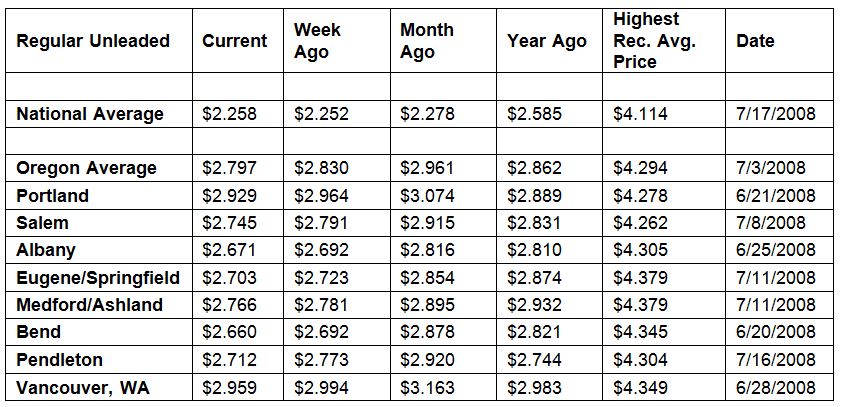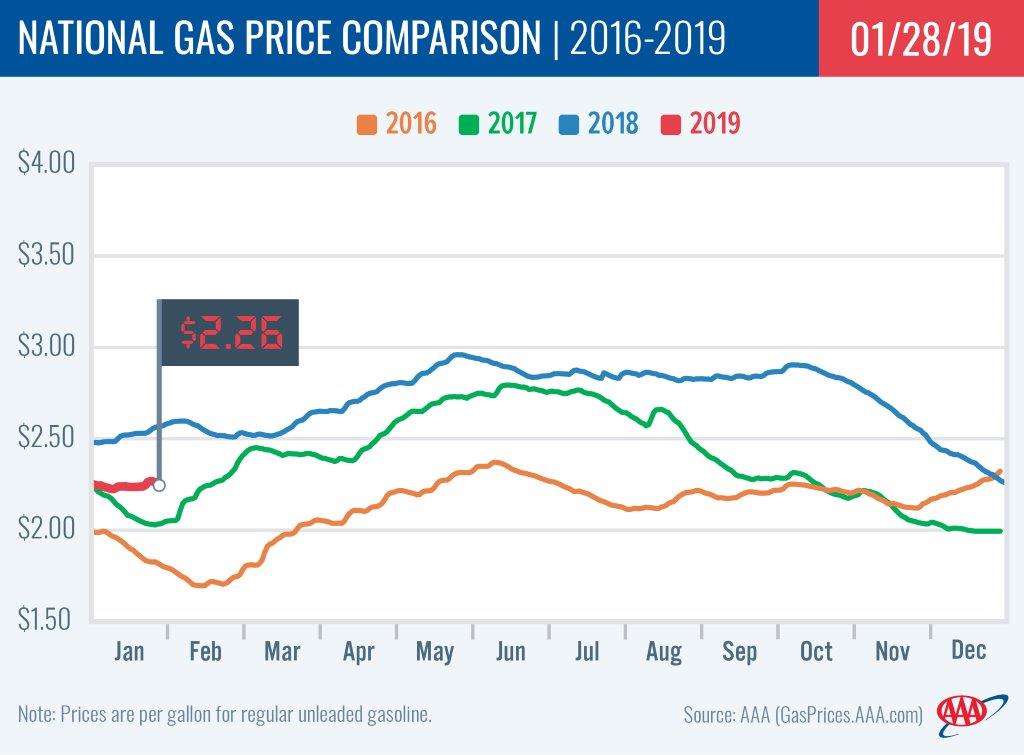Oregon has fifth-largest weekly drop in the Nation
PORTLAND, Ore., – Gas prices are increasing in nearly half of the states this week, sending the national average for regular slightly higher. For the week, the national average adds a penny to $2.26 a gallon while the Oregon average loses three cents to $2.80. This is the fifth-largest weekly drop in the nation. The Oregon average is now at its lowest price since January 2018.
“The fluctuating national and state gas price averages come alongside an increase in gasoline demand in the U.S. and also reflect the higher crude oil prices we’ve seen in the last few weeks,” says Marie Dodds, public affairs director for AAA Oregon/Idaho. “AAA predicts gas prices will hold steady or decrease this week, due to gasoline stocks sitting at their highest level on record at 259.1 million barrels along with reduced demand due to extremely cold weather over much of the Midwest and East Coast.”
Oregon is one of 28 states and the District of Columbia where gas prices are lower week-over-week. Utah (-5 cents) has the largest drop, followed by Kentucky (-5 cents). Idaho (-3 cents) and Oregon (-3 cents) are tied for the fifth-largest weekly drop in the nation. Georgia (+5 cents) has the largest weekly increase. This week two states, Hawaii and California, have averages at or above $3 a gallon, same as a week ago.
Oregon is one of 31 states and the District of Columbia with lower prices now than a month ago. The national average is two cents less and the Oregon average is 16 cents less than a month ago. This is the eighth-largest monthly drop in the nation. Utah (-24 cents) has the largest monthly decrease. Florida (+8 cents) has the largest month-over-month increase.
The West Coast continues to have the most expensive gas prices in the nation with all of the region’s states landing on the top 10 most expensive list. Hawaii is most expensive for the second week in a row followed by California, Washington, Alaska, Nevada and Oregon rounding out the top six. Oregon is sixth most expensive for the fourth week in a row. While expensive, prices are falling with all state averages moving lower on the week. Arizona (-4 cents) has the region’s largest drop.
| Rank | Region | Price on 1/29/19 | |
| 1 | Hawaii | $3.25 | |
| 2 | California | $3.24 | |
| 3 | Washington | $2.91 | |
| 4 | Alaska | $2.89 | |
| 5 | Nevada | $2.87 | |
| 6 | Oregon | $2.80 | |
| 7 | District of Columbia | $2.54 | |
| 8 | Arizona | $2.51 | |
| 9 | New York | $2.50 | |
| 10 | Connecticut | $2.50 |
The latest report from the U.S. Energy Information Administration (EIA) shows that West Coast gasoline stocks grew by approximately 900,000 bbl to 32.4 million bbl. However, stocks are approximately 2.2 million bbl lower than at this time last year, which could cause prices to spike if there is a supply challenge in the region this week.
The nation’s cheapest markets are Missouri ($1.91) and Oklahoma ($1.94). In all, seven states have averages below $2 a gallon this week down from nine states a week ago.
Oregon is one of 48 states and the District of Columbia where drivers are paying less than a year ago to fill up. The national average is 33 cents less and the Oregon average is seven cents less than a year ago. Iowa (-54 cents) has the greatest year-over-year decrease; Nevada (+14 cents) and Arizona (+13 cents) are the only two states with year-over-year increases.
Oil Market Dynamics
Oil prices fell slightly last week after three consecutive weeks of increases after new EIA data showed that domestic crude oil inventories grew by an astonishing 8 million bbl last week. At 445 million bbl, the current crude inventory level is approximately 33 million bbl higher than last year at this time.
This week oil prices moved higher after the U.S. imposed sanctions on Venezuela’s state-owned oil firm. The political turmoil in Venezuela, which has seen reduced crude production during its prolonged political upheaval and economic decline, could elevate crude prices. The Trump Administration decided to recognize Venezuela’s opposition leader as interim president. Implementing crude sanctions could exert global pressure that pushes the sitting president out of office, while tightening the global supply of crude and raising crude prices.
In related news, Baker Hughes Inc. reported that the U.S. added 10 oil rigs, bringing the total to 862. When compared to last year at this time, there are 103 more rigs this year.
At the close of Friday’s formal trading session on the NYMEX, WTI increased 56 cents to settle at $53.69. At the close of Monday’s formal trading session on the NYMEX, WTI lost $1.70 to settle at $51.99. Today crude is trading around $53, compared to $52 a week ago. Crude prices are up about 17 percent in the last month and are about $14 per barrel lower than a year ago.
Drivers can find current gas prices along their route with the free AAA Mobile app for iPhone, iPad and Android. The app can also be used to map a route, find discounts, book a hotel and access AAA roadside assistance. Learn more at AAA.com/mobile.
Diesel
For the week, the national average holds steady at $2.92 a gallon. Oregon’s average drops a penny to $3.07. A year ago the national average for diesel was $2.98 and the Oregon average was $3.07.
Find current fuel prices at GasPrices.AAA.com.
AAA news releases, high resolution images, broadcast-quality video, fact sheets and podcasts are available on the AAA NewsRoom at NewsRoom.AAA.com.



